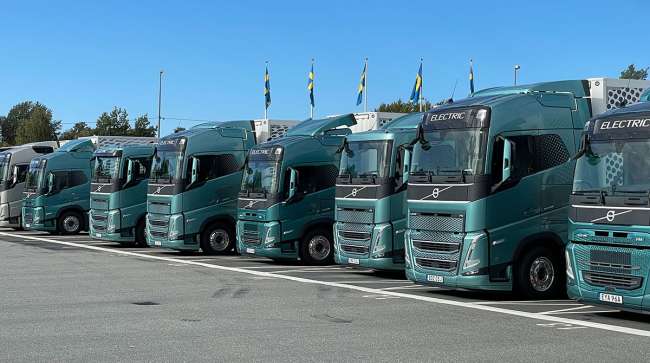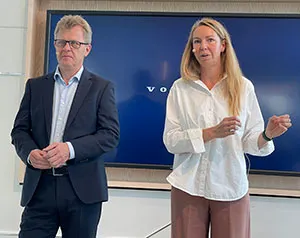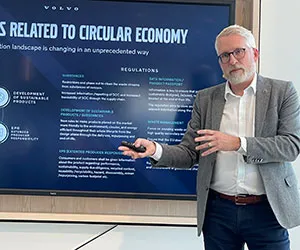Volvo Charts Customer-Focused Path for Zero-Emission Goals

[Stay on top of transportation news: Get TTNews in your inbox.]
GOTHENBURG, Sweden — Leaders from Volvo Trucks said they’re taking a customer-focused approach to achieving corporate goals for reduction of carbon emissions, including drilling down on fleets’ operations to identify and fine-tune opportunities where adoption of zero-emission trucks will make business sense.
“We need to then create an ecosystem, and we need to give our customers peace of mind” to adopt zero-emission vehicles, Volvo Trucks President Roger Alm said Sept. 13 from a media event held at the company’s headquarters, during which he and other leaders outlined strategies the truck manufacturer is implementing to help customers incorporate zero-emission vehicles into their fleets.
“There are challenges — batteries, range, charging infrastructure, new technology. So we need to compile these in an ecosystem so that we have that to support our customers in this transformation,” he said.
Volvo hosted the two-day event to offer transportation media a comprehensive look at its battery-electric, fuel cell and liquefied natural gas offerings — including time behind the wheel with some at the Volvo Trucks Experience Center — and coincided with the announcement that Volvo would begin producing electric trucks at its factory in Ghent, Belgium.
We are ramping up electric truck volumes. Electric @VolvoTrucks are now built in four factories – three in Europe and one in the US. https://t.co/KQNoeo17ld — Volvo Group (@VolvoGroup) September 14, 2023
It is the fourth Volvo factory to launch serial production of electric trucks; the third in Europe, following factories in Blainville, France, and Tuve, Sweden. The company’s plant in Dublin, Va. — which makes trucks for Volvo Trucks North America — builds the VNL Electric and VNR Electric models.
Volvo Trucks has committed to have 50% of the vehicles it sells be electric by 2030 and to have 100% of them be net zero-emission by 2050, so finding a way to make the vehicles work for their customers is a top-of-mind focus, Alm said.

Roger Alm and Jessica Sandstrom address the media at company headquarters. (Joe Howard/Transport Topics)
One way it is doing so is through route simulators, which pull data from routes companies run to help determine where a zero-emission vehicle could make business sense. Jessica Sandstrom, the company’s SVP for product development, said the point of this broad-based effort is to give fleets clear data on how and where zero-emission trucks — and battery-electric truck in particular — could work in their operations. She noted that commercial users cannot stand for uncertainty like that experienced by drivers of some electric cars, where conditions and usage habits take a toll on range.
“We can’t have it like that,” she said. “Our truck needs to work every day, in reality, transporting goods. So, our route simulator is used in several of the steps when we are deploying the electric trucks. First it is when we talk to the customers trying to find the flows where it is best to operate. There we specify the truck. We also come with recommendation on charging power and where to have charging stations.”
Beyond that, the company also offers a simulation program to the back office to help develop an operational plan for the trucks.

Lars Martensson says, “We need to make sure that when we produce trucks, we avoid hazardous materials in the trucks because society doesn’t want hazardous substances to recirculate.” (Joe Howard/Transport Topics)
“Then there is another version that the dispatcher is using,” Sandstrom said, “so that every day you can look at, ‘How will this work in reality for my driver if I make this choice today?’ ” She noted that the company is constantly reviewing and upgrading the programs to ensure they’re producing good results for customers. And so far, Sandstrom said, they are. “When the tools are used in the right way, we are pretty good at predicting how it would work,” she said.
Alm stressed that the company sees achieving its zero-emission goals as part of a higher purpose that the transportation sector specifically and society more broadly must embrace.
“There is a change in the globe,” he said. “It will concern all of us. The climate will have a great impact on what we should do, because we need to change our way of living. We cannot handle the climate situation and the global situation like we do today. We need to change our way of living, and our way of acting, and our way of being. If we don’t do that, we maybe won’t have a blue sky.”

Volvo Trucks Experience Center. (Joe Howard/Transport Topics)
Alm added, “We need to act together.”
That holistic approach extends to end-of-life treatment of trucks, noted Lars Martensson, the company’s environment and innovation director. He said that 95% of a Volvo VNR Electric is recyclable, and stressed that buyers should consider this when the time comes for the trucks to be taken out of service. “Buyers will see more value in a truck that is recyclable at the end of its life,” he said.
That starts with building trucks in a sustainable way, Martensson noted. “We need to make sure that when we produce trucks, we avoid hazardous materials in the trucks,” he said, “because society doesn’t want hazardous substances to recirculate.”
He added this is an increasing area of focus among European regulators. “We need to make sure that we step-by-step phase out what society is perceiving as hazardous in order to enable a more circular use of materials and components.”
While these changes require a new way of thinking for both manufacturers and fleets, Alm stressed that transportation has navigated through times of transformation before, and can again. He pointed to a photo of New York City in the early 19th century, when the roads were lined with horses and buggies.
“Transformation has been here before, and it will come again,” he said. “At that point in time, the transformation was done to be more efficient. Now, we need to do this transformation to change the climate situation, and take care of our climate in a different way.”
Want more news? Listen to today's daily briefing below or go here for more info:




